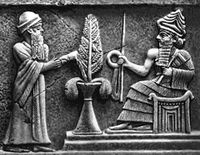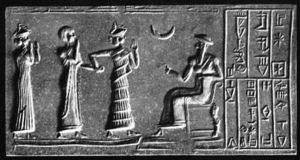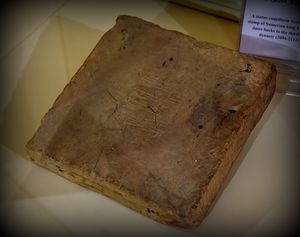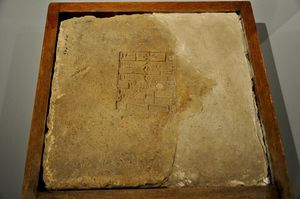أور نمو
| أور نمو | |
|---|---|
| ملوك أور | |
 Stela of Ur-Nammu | |
| تبعه | شولجي |
| العقيلة | اوتوحيكال |
| الديانة | الميثولوجيا السومرية |
أور نمو (أورنامو أو أور انغور أو أور كور)(2047-2030 ق م) مؤسس سلالة أور الثالثة في بلاد الرافدين كما أنه مؤسس أول شريعة قانونية في التاريخ التي سبقت شريعة الملك البابلي حمورابي بثلاثة قرون.
تمكن أورنمو من توحيد المدن السومرية من (أور و إريدو و أوروك و لكش و نيبور و كيش و أداب و اوما ) ضد حكم الكوتيين وتمكن من استعادة حكم بلاد الرافدين من الكوتيين الذين احتلوه والذين اسقطوا الإمبراطورية الأكدية، ولقب نفسه بملك بلاد سومر وأكد.
أورنمو تمكن من بناء عدة معابد منها مبنى الزقورة العظيمة في أور وكذلك قام ببناء معابد في مدن أخرى كـنيپور ولارسا وكيش وأداب واوما وقام بتشريع أول شريعة قانونية في التاريخ.
قتل سنة 2030 ق.م. بعد معركة أمام الكوتيين وبعد أن تمكن من تحرير كامل الخليج السومري من السيطرة الكوتية وخلفه بعده ابنه شولجي.
عهده
Year-names are known for 17 of Ur-Nammu's 18 years, but their order is uncertain. One year-name of his reign records the devastation of Gutium, while two years seem to commemorate his legal reforms: "Year in which Ur-Nammu the king put in order the ways (of the people in the country) from below to above", and "Year Ur-Nammu made justice in the land".[1]
Among his military exploits were the conquest of Lagash and the defeat of his former masters at Uruk. He was eventually recognized as a significant regional ruler (of Ur, Eridu, and Uruk) at a coronation in Nippur, and is believed to have constructed buildings at Nippur, Larsa, Kish, Adab, and Umma. He was known for restoring the roads and general order after the Gutian period.[2]
Ur Nammu was also responsible for ordering the construction of a number of stepped temples, called ziggurats, including the Great Ziggurat of Ur.[3]
He was succeeded by his son Shulgi, after an 18-year reign. His death on the battle-field against the Gutians (after he had been abandoned by his army) was commemorated in a long Sumerian poetic composition.[2]
النصب
In 1925, a shattered nine-foot tall limestone pillar was discovered in Mesopotamia. Under the remote supervision of Leonard Woolley, it was reconstructed by the Penn Museum. In 1985, Jeanny Canby determined that it had been pieced back incorrectly. She removed the plaster filler of the stele, and added the rearranged pieces she found in the museum's storeroom, and discovered the figure of a courtesan embracing a deity. "It's an amazingly intimate scene for a royal monument," she said.[4]
انظر أيضاً
الهامش
- ^ Year-names for Ur-Nammu
- ^ أ ب Hamblin, William J. Warfare in the Ancient Near East to 1600 BC. New York: Routledge, 2006.
- ^ "Archived copy". Archived from the original on 2007-07-08. Retrieved 2007-07-08.
{{cite web}}: Unknown parameter|deadurl=ignored (|url-status=suggested) (help)CS1 maint: archived copy as title (link) - ^ Sullivan, Patricia (November 28, 2007). "Archaeologist Jeanny 'Jes' Canby". The Washington Post.
وصلات خارجية
- Site drawings of the temple built by Ur-Nammu at Ur to the moon god Nanna.
- Nabonidus dedication to the Ziggurat
- The Code of Ur-Nammu at Britannica
- Foundation Figurine of King Ur-Nammu at the Oriental Institute of Chicago
- The "Ur-Nammu" Stela. Penn Museum. 2006. ISBN 978-1-931707-89-3.
- Site drawings of the temple built by Ur-Nammu at Ur to the moon god Nanna.
| مشاهير حكام سومر | |||
|---|---|---|---|
| الملوك قبل الطوفان | ألوليم • دوموزيد الراعي • زيوسودرا | الأسرة الثالثة من كيش | كوبابا |
| الأسرة الأولى من كيش | Etana • Enmebaragesi | الأسرة الثالثة من أوروك | لوگل-زاگى-سي |
| الأسرة الأولى من أوروك | إنمركار • لوگلباندا • دوموزيد الصياد • گلگامش | أسرة أكاد | سرگون • (إنحدوانا)† • رموش • مانيشتوشو • نرم-سن • شر-كالي-شري • دودو • Shu-turul |
| الأسرة الأولى من أور | مسقلمدق* • مشآنىپادا • پوابي* | ||
| الأسرة الثانية من أوروك | Enshakushanna | الأسرة الثانية من لگش | پوزر-ماما • گوديا |
| الأسرة الأولى من لگش | اور-نانشه • إياناتوم • إن-أنا-توم الأول • إنتمنا • أوروكأگينا | الأسرة الخامسة من أوروك | اوتو-حگل |
| أسرة أدب | Lugal-Anne-Mundu | الأسرة الثالثة من اور | اور نـَمـّو • شولگي • أمار-سين • شو-سين • إبي-سين |
| * مسقلمدق وپوابي، بالرغم من أنهما لم يكونا حكاماً، فقد اشتهرا بسبب اللقى في مقبرتيهما.
† إنحدوانا، بالرغم من أنها لم تكن حاكمة، فقد كانت كاهنة اشتهرت بأناشيدها. | |||


